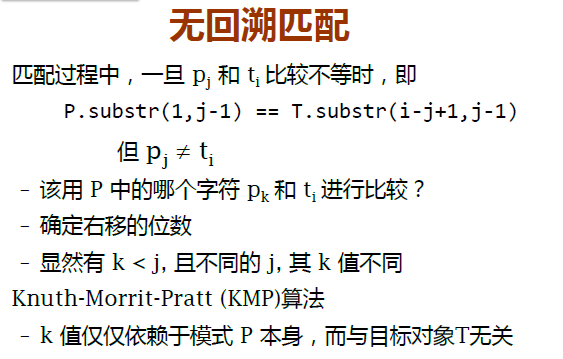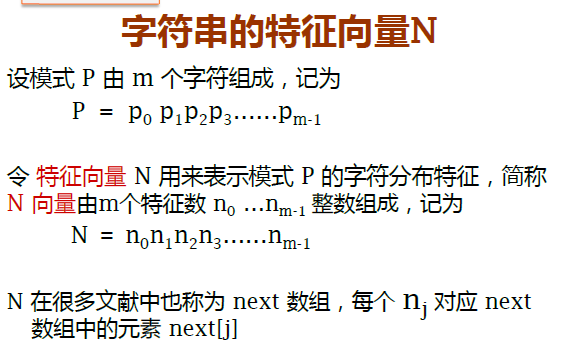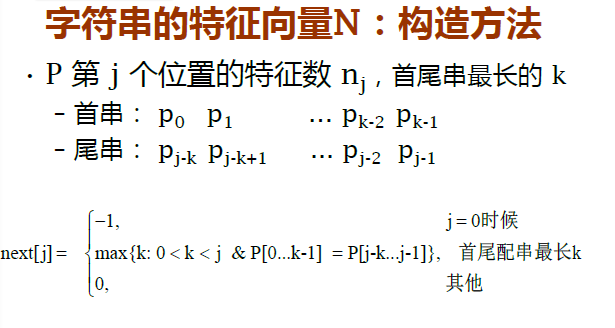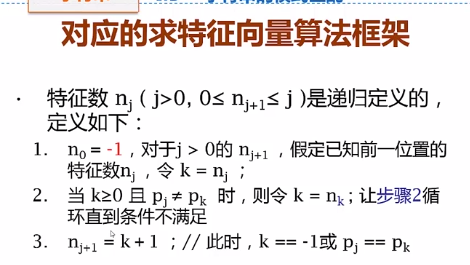本文内容来自中国大学MOOC上北京大学的数据结构与算法的公开课。
主要从字符串string相关编码方面进行笔记的梳理,涉及:
- 字符串常见操作实现
- 字符串的运算算法实现
- 字符串的快速模式匹配 (KMP)
字符串的存储和常见操作实现
1
2
3
4
5
6
7
8
9
10
11
12
13
14
15
16
17
18
19
20
21
22
23
24
25
26
27
28
29
30
31
32
33
34
35
36
37
38
39
40
41
42
43
44
45
46
47
48
49
50
51
52
53
54
55
56
57
58
59
60
61
62
63
64
65
66
67
68
69
70
71
72
73
74
75
76
77
78
79
80
81
82
83
84
85
86
87
88
89
90
91
|
int strlen(char d []){
int i = 0;
while(d[i] != '\0'){
i++;
}
return i;
}
char *strcpy(char *d, char *s){
int i = 0;
while(s[i] != '\0'){
i++;
d[i] = s[i];
}
d[i] = '\0';
return d;
}
int strcmp(const char *s1, const char *s2){
int i = 0;
for(i = 0; s1[i] == s2[i]; i++){
if(s1[i] == s2[i] && s1[i] == '\0')
return 0;
}
return (s1[i] - s2[i]) / abs(s1[i] - s2[i]);
}
class String{
private:
char* str;
int size;
public:
String(char *str){
size = strlen(str);
str = new char[size + 1];
assert(str != NULL);
strcpy(this->str, str);
}
~String(){
delete [] str;
str = NULL;
}
int size(){
return size;
}
char* c_str(){
return str;
}
String operator=(String &s){
if(str != s.size()){
delete []str;
str = new char[s.size() + 1];
assert(str != NULL);
size = s.size();
}
strcpy(str, s.c_str());\
return *this;
}
String substring(int start, int num){
assert(start >= 0 && start + num - 1< size);
char * newstr = new char[num + 1];
int i = 0;
while(i != num){
newstr[i] = str[start + i];
i++;
}
newstr[i] = '\0';
return String(newstr);
}
void reverse(){
int start = 0;
int end = size - 1;
while(start != end){
int tmp = str[start] - str[end];
if(tmp > 0){
str[start] = str[start] - tmp;
str[end] = str[end] + tmp;
}
else if(tmp < 0){
str[end] = str[end] - tmp;
str[start] = str[start] + tmp;
}
end--;
start++;
}
}
}
|
字符串的模式匹配
朴素模式匹配法(穷举法)
字符串匹配就是给定一个字符串,想要判断一下在该字符串中是否存在有一个子串,有则返回第一个匹配字符的下标,否则返回-1
1
2
3
4
5
6
7
8
9
10
| int fidPat_3(string T, string P, int startIndex){
for(int g = startIndex; g <= T.length() - P.length(); g++){
for(int j = 0; (j < P.length() && P[j] == T[g + j]); j++){
if(j == P.length()-1){
return g;
}
}
}
return -1;
}
|
该算法最坏情况下的复杂度是 O(m × n), m 为长串的长度,n为短串的长度。
快速模式KMP算法
KMP算法就是在朴素匹配算法的基础之上,对每次滑动的位数 n 进行了提前的计算,减少了不要的冗余计算。
而这个滑动的位数计算的思想就是先建立一个关于模式串P中每一个字符的特征向量表。
其中next数组就是所谓的特征向量表。当 j != 0 时,向量元素值的含义就是在模式串本身的从0到 j - 1的子串中,首尾的的连续等长子串相等时的最大长度值k。
这样当模式串的第 j + 1个元素匹配错误的时候,我们就可以直接确定下一步滑动的位数为 j - k 位。
理由是模式串首部的前k个字符和模式串的 【j - k : j 】的子串相匹配,下一次匹配时,可以用首部的串代替尾部的子串,然后减少比较次数。
1
2
3
4
5
6
7
8
9
10
11
12
13
14
15
16
17
18
19
20
21
| int KMPMatching(string T, string P, int *N, int start){
int j = 0;
int i = start;
int plen = P.length();
int tlen = T.length();
if(tlen - start < plen)
return -1;
while(j < plen && i < tlen){
if(j == -1 || T[i] == P[j]){
i++;
j++;
}
else{
j = N[j];
}
}
if(j >= plen){
return (i - plen);
}
return -1;
}
|
1
2
3
4
5
6
7
8
9
10
11
12
13
14
15
16
17
18
19
20
21
| int* fineNext(string P){
int j, k;
int m = P.length();
assert(m > 0);
int *next = new int[n];
assert(next != NULL);
next[0] = -1;
j = 0; k = -1;
while(j < m - 1){
while(k > 0 && P[k] != P[j]){
k = next[k];
}
j++; k++; next[j] = k;
if (P[k] == P[j]){
next[j] = next[k];
}
else next[j] = k;
}
return next;
}
|



